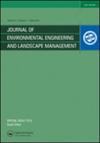以废铁为前驱体绿色合成氧化铁纳米颗粒去除水介质中的铅(ii)
IF 1.1
4区 环境科学与生态学
Q4 ENVIRONMENTAL SCIENCES
Journal of Environmental Engineering and Landscape Management
Pub Date : 2022-06-14
DOI:10.3846/jeelm.2022.16747
引用次数: 4
摘要
在本研究中,以废铁为原料,采用绿色合成方法制备了低成本、环保、单步、高产的新型氧化铁纳米颗粒(NP),以去除水溶液中的Pb(II)。用紫外-可见光谱法对合成的纳米颗粒进行了表征。通过XRD对其晶体结构和相变进行了分析。进行FE-SEM以了解氧化铁纳米颗粒的形态,并且通过BET表面积分析仪发现平均表面积为46.856m2/g。XRD图显示,当在开放气氛中进行合成时,所获得的磁铁矿Fe3O4结合了FeO和Fe2O3。SEM图像证实了尺寸为31nm的氧化铁纳米颗粒的形成。通过分批研究,优化不同的操作参数,如pH、时间、吸附剂用量、金属离子的初始浓度、接触时间,以提高吸附剂的去除效率。所获得的pHzpc(pH5.7)值表明,在较高的pH下,吸附过程将是有利的。铅的最大去除率和吸收能力分别为98%和68.07mg/g。用Langmuir和Freundlich等温线方程对获得的吸附数据进行分析。Langmuir等温线拟合平衡数据的方法优于Freundlich等温线。结果表明,金属离子的均相吸附有利于非均相吸附。通过Langmuir等温线计算出氧化铁纳米粒子的最大吸附量为Qmax(68.07)mg/g。此外,还用伪一阶和伪二阶动力学方程分析了金属离子随时间的吸附。动力学数据更多地拟合在拟二阶反应中。通过拟二阶方程计算的吸附容量为qe(51.81)mg/g。该文献证实,以废铁为前体合成的纳米颗粒被证明是去除重金属的一种有吸引力的选择。本文章由计算机程序翻译,如有差异,请以英文原文为准。
GREEN SYNTHESIS OF IRON-OXIDE NANOPARTICLES USING SCRAP IRON AS PRECURSOR FOR THE REMOVAL OF PB (II) FROM AQUEOUS MEDIUM
In the present study, low-cost, environmentally friendly, single-step, high productive novel Iron-oxide nanoparticles (NPs) were prepared from scrap iron using a green synthesis method to remove Pb (II) from aqueous solution. The characterization of synthesized nanoparticles was conducted by UV-vis spectroscopy. The crystalline structure and the phase change were clarified by XRD. FE-SEM was done to know the morphology of iron oxide nanoparticles, and the average surface area of 46.856 m2/g was found by the BET surface area analyzer. The XRD plot shows that the obtained magnetite Fe3O4 combines FeO and Fe2O3 as the synthesis was conducted in the open atmosphere. The SEM images confirm the formation of iron oxide nanoparticles with a size of 31 nm. The removal efficiency of the adsorbent was carried out by optimizing the different operational parameters like pH, time, adsorbent dosage, initial concentration of metal ion, contact time by batch studies. The obtained pHzpc (pH 5.7) value indicates that the adsorption process will be favorable at higher pH. The maximum removal efficiency and uptake capacity of lead were 98% and 68.07 mg/g, respectively. Adsorption data obtained were analyzed with Langmuir and Freundlich isotherm equations. The equilibrium data are fitted by Langmuir isotherm in a superior way than that of Freundlich isotherm. The results show that homogeneous adsorption of the metal ion favors heterogeneous adsorption. The maximum adsorption capacity of iron oxide NPs was calculated through Langmuir isotherm was Qmax (68.07) mg/g. Moreover, the adsorption of metal ions with time was also analyzed with the pseudo 1st and pseudo 2nd kinetic equations. The kinetic data are fitted more in the pseudo 2nd order reaction. Adsorption capacity calculated through pseudo 2nd order equation was qe (51.81) mg/g. This literature verifies that NPs synthesized from scrap iron as precursors prove to be an attractive option for removing heavy metals.
求助全文
通过发布文献求助,成功后即可免费获取论文全文。
去求助
来源期刊
CiteScore
1.90
自引率
7.70%
发文量
41
审稿时长
>12 weeks
期刊介绍:
The Journal of Environmental Engineering and Landscape Management publishes original research about the environment with emphasis on sustainability.

 求助内容:
求助内容: 应助结果提醒方式:
应助结果提醒方式:


